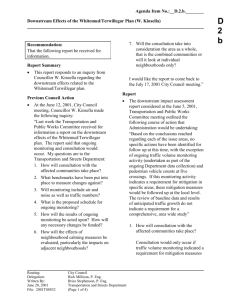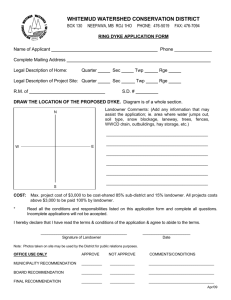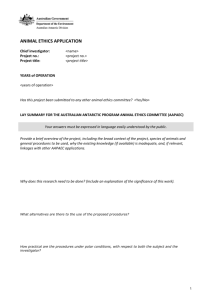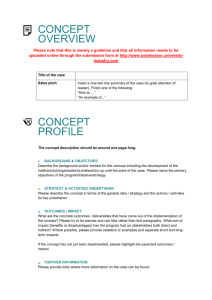Report for Transportation and Public Works
advertisement
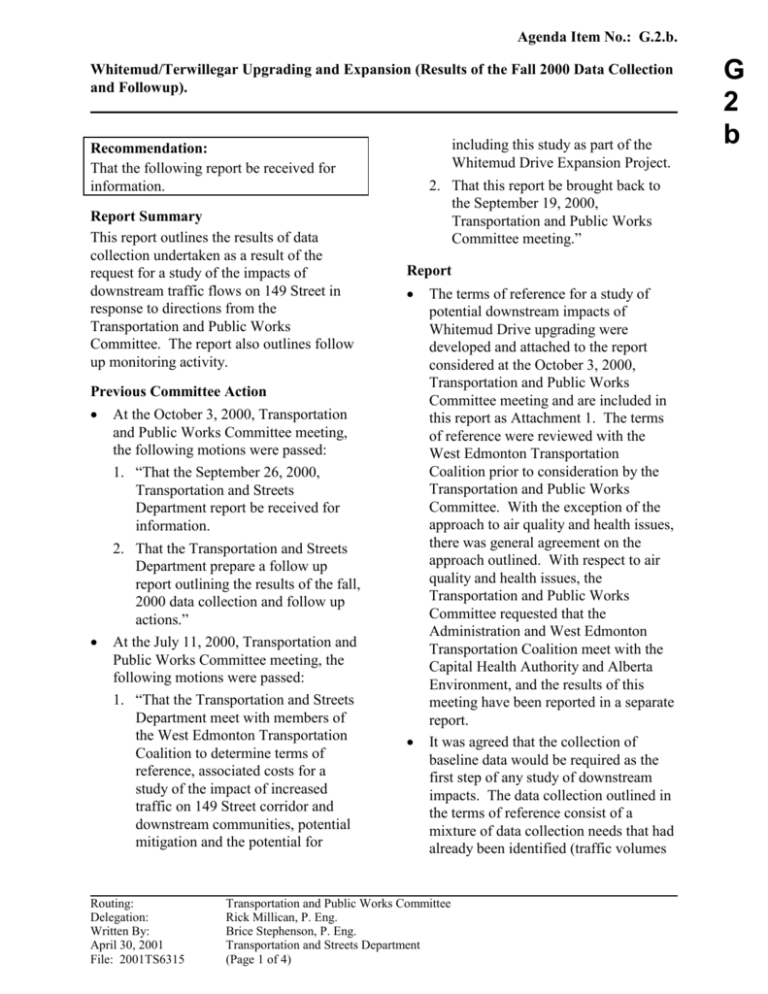
Agenda Item No.: G.2.b. Whitemud/Terwillegar Upgrading and Expansion (Results of the Fall 2000 Data Collection and Followup). including this study as part of the Whitemud Drive Expansion Project. Recommendation: That the following report be received for information. Report Summary This report outlines the results of data collection undertaken as a result of the request for a study of the impacts of downstream traffic flows on 149 Street in response to directions from the Transportation and Public Works Committee. The report also outlines follow up monitoring activity. 2. That this report be brought back to the September 19, 2000, Transportation and Public Works Committee meeting.” Report Previous Committee Action At the October 3, 2000, Transportation and Public Works Committee meeting, the following motions were passed: 1. “That the September 26, 2000, Transportation and Streets Department report be received for information. 2. That the Transportation and Streets Department prepare a follow up report outlining the results of the fall, 2000 data collection and follow up actions.” At the July 11, 2000, Transportation and Public Works Committee meeting, the following motions were passed: 1. “That the Transportation and Streets Department meet with members of the West Edmonton Transportation Coalition to determine terms of reference, associated costs for a study of the impact of increased traffic on 149 Street corridor and downstream communities, potential mitigation and the potential for Routing: Delegation: Written By: April 30, 2001 File: 2001TS6315 The terms of reference for a study of potential downstream impacts of Whitemud Drive upgrading were developed and attached to the report considered at the October 3, 2000, Transportation and Public Works Committee meeting and are included in this report as Attachment 1. The terms of reference were reviewed with the West Edmonton Transportation Coalition prior to consideration by the Transportation and Public Works Committee. With the exception of the approach to air quality and health issues, there was general agreement on the approach outlined. With respect to air quality and health issues, the Transportation and Public Works Committee requested that the Administration and West Edmonton Transportation Coalition meet with the Capital Health Authority and Alberta Environment, and the results of this meeting have been reported in a separate report. It was agreed that the collection of baseline data would be required as the first step of any study of downstream impacts. The data collection outlined in the terms of reference consist of a mixture of data collection needs that had already been identified (traffic volumes Transportation and Public Works Committee Rick Millican, P. Eng. Brice Stephenson, P. Eng. Transportation and Streets Department (Page 1 of 4) G 2 b Whitemud/Terwillegar Upgrading and Expansion (Results of the Fall 2000 Data Collection and Followup) and travel times on arterial roadways and in the vicinity of the Crestwood Traffic Plan), with the addition of some additional daily volume counts on some residential roadways within neighbourhoods, as well as three locations where noise tests would be undertaken. It was not possible to identify what specific mitigation measures would be necessary to deal with the downstream impacts or what process would be utilized to address these concerns prior to the data collection. In addition to reviewing the current situation, traffic volume growth associated with anticipated development in the city and the planned widening of Whitemud Drive would be considered for each of the areas. Based on historical experience with studies of this type, it was identified that three possible outcomes could occur once the data collection was completed: 1. If the data indicates that existing conditions would not require mitigation, and anticipated volume increases associated with growth and Whitemud Drive widening could be accommodated with limited mitigation, then an ongoing monitoring program would be proposed and accommodated through the normal work program. Development of a mitigation program would focus on the specific problem area. 2. If the data indicates that specific neighbourhood problems exist, or that a community is at risk of (Page 2 of 4) shortcutting traffic problems as a result of expected traffic growth, then consideration of a neighbourhood traffic plan would be required within a specific community. It is noted that a number of communities adjacent to 149 Street and Stony Plain Road have already implemented measures to discourage shortcutting traffic (an inventory of these measures is included in Appendix A of Attachment 1). Typically, neighbourhood traffic plans are done on a prioritized basis as City staff resources permit. If a neighbourhood were to have a study undertaken in advance of the city- wide priority, it would require the specific approval of funds to undertake the work, and would likely require the use of consultants. 3. If the data indicates a requirement for measures that extend over a wide area, then it is anticipated that a study using a facilitated process involving both the communities of the West Edmonton Transportation Coalition and users of the arterial roadways (such as Riverbend and West Jasper Place). The most recent example of a facilitated process of this type was the Southwest Transportation Study, which reviewed short term transportation options for 114 Street and alternative routes. This study cost approximately $250,000 and required over a year to complete. Again, budget approval for work of Whitemud/Terwillegar Upgrading and Expansion (Results of the Fall 2000 Data Collection and Followup) this type would require consideration of the priority of this work and impact on other activities in the planned work program and budget. Attachment 2 outlines the results of the data collection and review of anticipated impact of further traffic growth. For each of the impact areas, the conclusions are as follows: Air quality - As noted in the Terms of Reference (Attachment 1), the City has provided the West Edmonton Transportation Coalition with information on the air quality data, collected by Alberta Environment at the northwest site in the vicinity of 127 Street as an indication of comparable conditions. Alberta Environment is currently monitoring air quality near Whitemud Drive. The City has undertaken forecasts of emissions in the vicinity of Whitemud Drive and has estimated that overall emissions will decrease over time (i.e. improvements in technology will result in reductions in emissions, despite an increase in overall volumes). As lesser volume increases are forecast to occur on both 149 Street and Stony Plain Road, it is anticipated that emissions will also be reduced along these roadways. Health issues – As outlined in Attachment 1, meetings have occurred with the Capital Health Authority and results are documented separately. (Page 3 of 4) Traffic Shortcutting – A review of data gathered in Attachment 2 outlines that there are currently two areas experiencing shortcutting traffic; Crestwood neighbourhood, focussing on 95/96 Avenue, and 95 Avenue through West Jasper/Sherwood. In the case of Crestwood, a neighbourhood traffic plan was implemented in 2000. In the case of West Jasper/Sherwood, the community league was contacted to determine if there was interest in pursuing traffic calming along the section of 95 Avenue between 149 and 156 Street, and the community league was not supportive of any traffic restrictions being imposed at this time. Attachment 2 also indicates the results of an assessment of “shortcutting potential” along roadways with anticipated traffic growth. Given the intersection improvements implemented within the last few years, notably at 87 Avenue – 149 Street and Stony Plain Road – 149 Street, it was concluded that there is minimal risk of additional local or collector roadways being subject to shortcutting. It was also noted that limited traffic growth can occur on the arterial roadways during peak periods. Traffic noise – noise measurements were undertaken at the three locations identified in Attachment 1 as these were considered to represent a “worst case” for homes closest to 149 Street, Stony Plain Road and Whitemud/Terwillegar Upgrading and Expansion (Results of the Fall 2000 Data Collection and Followup) 142 Street and flanking these roads. Although the locations on 142 Street and 149 Street do exhibit noise levels near 65 dBA, neither the current levels or projected levels based on anticipated traffic volume increases would result in these properties exceeding 70 dBA, where the existing noise policy would require the City to undertake action. It is also noted that the fact, that none of these roadways are now or in the future planned to be truck routes, will ensure that minimal change in noise levels is experienced. Neighbourhood severance – A database documenting existing pedestrian crossing protection on all arterial and collector roadways was created to assist the community in assessing the concern of potential neighbourhood severance. In addition, the assessment of potential for further traffic growth during peak period was undertaken. It was identified that a number of pedestrian crossings have not been recently assessed for upgraded protection. Counts at five locations are currently being undertaken. Property values – The Asset Management and Public Works Department, Land and Buildings Branch was requested to research current property values along 149 Street and Stony Plain Road for current and projected daily traffic volumes. The assessment concluded that “there likely will not be any impacts along Stony Plain Road on 149 Street on residential property values resulting from downstream traffic flows associated with the Whitemud Drive upgrade project.” Based on the conclusions reached regarding each of the issue areas, no specific actions have been identified for follow up at this time, with the exception of ongoing traffic volume monitoring activity (undertaken as part of the ongoing Department data collection) and pedestrian vehicle counts at five crossings. If this monitoring activity indicates a requirement for mitigation in specific areas, these mitigation measures would be followed up at a local level. The review of the baseline data and results of anticipated traffic growth do not indicate any requirement for a comprehensive area wide study. It is noted that a number of specific mitigation measures immediately adjacent to Whitemud Drive are identified within the Whitemud Drive/Terwillegar Drive Concept Planning Study Report. Background Information Attached 1. Study of Potential Downstream Impacts of Whitemud Drive Upgrading – Terms of Reference. 2. Downstream Assessment Review of Data Collection and Requirement for Followup Activity. Others Approving This Report 1. Bill Burn – Asset Management and Public Works Department (Page 4 of 4)
